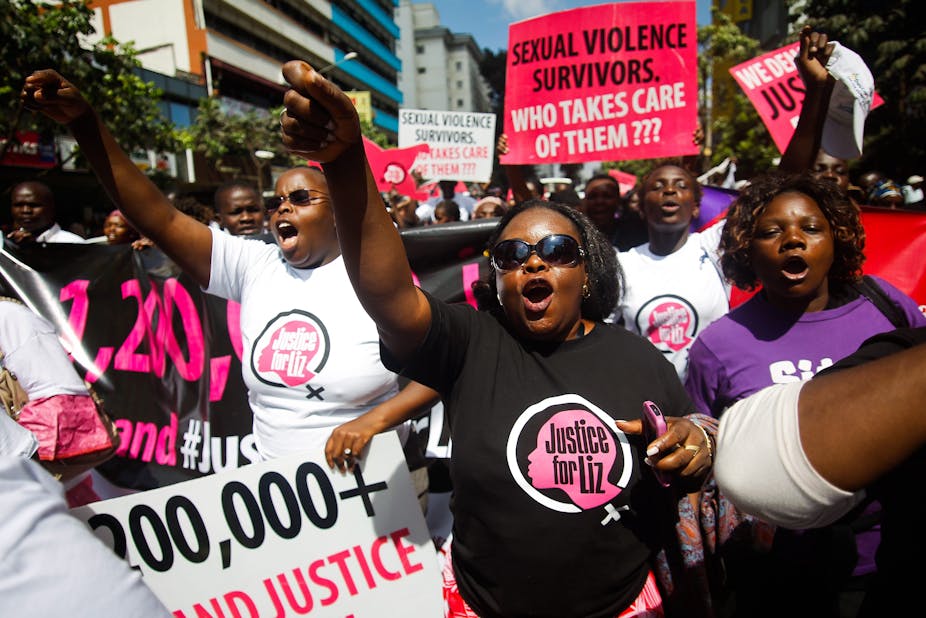It’s estimated that 14% of Kenyan women and 6% of men aged 15-49 have experienced sexual violence at least once in their lifetime. In Kenya women and girls experience sexual violence more than men and boys.
In my research I looked at sexual violence against minors in Kenya. Most Kenyan adolescent girls are in fact perceived as women. The aim of my study was to explore how communities view sexual assault and how those perceptions contribute to the vulnerability of minors to sexual abuse.
In many parts of Kenya, as in so many patriarchal societies, men and women are raised differently. This upbringing creates imbalances in the power relations between them. Most young men are socialised to be sexually adventurous and aggressive as a way to prove their masculinity. Girls are expected to be chaste, domesticated and compliant. Women and girls who deviate from these designated roles risk disapproval from community members as well as physical and sexual violence.
These attitudes are particularly marked when it comes to the issue of rape. Myths, and false beliefs – misconceptions resulting from incorrect reasoning – about rape, rape victims, and rapists are rife in Kenya. For example, half of the population will blame a rape victim under any circumstance.
The common myths include: that rape is committed by a deviant and/or a stranger, that it is not that serious, that the man was provoked by the sexiness of the female, women mean yes when they say no, women are liars, and a man is entitled to the sex through marriage or purchase of gifts.
These attitudes place the blame on the victims, and don’t hold perpetrators accountable for their actions. And the victim’s credibility is questioned.
Survivors of rape in Kenya face numerous challenges. These include not being believed by service providers, being blamed for rape because of what they were wearing, and being drunk. They also experience delays at health facilities, police stations, and courts.
A change in the country’s laws would help alleviate the problem. But for that to happen more women would need to be elected to Parliament and to county assemblies. Another intervention that would help girls, in particular, would be proper education on sex, violence and rights at school.
Misconceptions perpetuated by media
In early June 2018, a 15-year-old schoolgirl at Moi Girls High School in Nairobi was sexually assaulted.. She didn’t receive emergency assistance. When she was eventually taken to a health centre, it was reported that no evidence of rape was found. The parents insisted on a second opinion and sent her to a credible public health facility for further tests which determined that she had been sexually assaulted.
The first move from Kenya’s Union of Post Primary Education Teachers was to protect union members who’d been accused of the rape. They called for “fairness” to be applied to the process.
A month later the union released a statement stating that the girl had been raped by her schoolmates, and not by any of the teachers. The union had no authority to comment publicly on a matter that was under investigation. The Standard newspaper carried the union’s allegations on its front page under the headline: ‘Teachers: Moi Girls rape was all fiction.’
The day the story was published there were calls on social media for action to be taken against the girl for spreading falsehoods.
The incident shows that there’s a need for media training when it comes to reporting rape. Callous reporting causes survivors to be victimised further.
Health and legal responses
Survivors may arrive at a health facility or police station in the morning, only to be served in the evening or the next day. This happens despite health care providers and police officers knowing that medical evidence to support rape allegations can only be obtained within the first 72 hours.
The longer the survivor waits, the less likely it is to find sound medical evidence (evidence of penetration includes presence of semen, pubic hairs, foreign fibres, blood, bite marks etc) of rape.
Health care providers and law enforcement officers also lack the training to conduct proper investigations. And corruption is a huge barrier to survivors accessing these services. Many survivors are asked to pay for post-rape medical services.
Others are asked to pay the police for them to do their jobs. The law stipulates that both these services should be offered free of charge.
What needs to be done?
Given the patriarchal nature of Kenyan society, men in the country define what is accepted as sexual violence.
An example of this is that marital rape is not criminalised in Kenya. This came about because male legislators – who were in the majority – blocked the inclusion of a clause on marital rape when the country’s first Sexual Offences Bill was tabled in 2006. They argued that married women could not withdraw consent for sex. These views are still held today.
The first order of business in the war against sexual violence in Kenya would be to elect more women to Parliament and to the county assemblies. More women legislators would ensure more progressive laws.
Secondly, the legislation and implementation of comprehensive sexuality education in Kenyan schools is imperative. This has still not been fully embraced because of the conservative leaning of Kenyan society. Sexuality education is important to teach young people about gender equality. It also dispels rape myth attitudes by informing society about the ramifications of sexual violence, and the need for post rape care.
Third, survivors of sexual violence need to be believed and not condemned. This is the only way to encourage victims to report incidents of sexual violence.
Fourth, health providers and law enforcement officers must be trained to conduct rigorous investigations so that prosecutions can be successful.
And finally, the law should enforce stiffer penalties for service providers who frustrate rape survivors.

